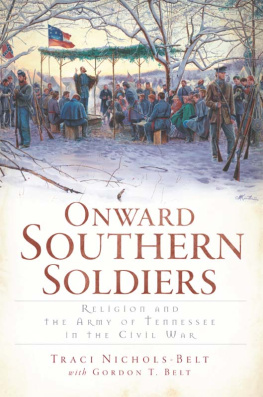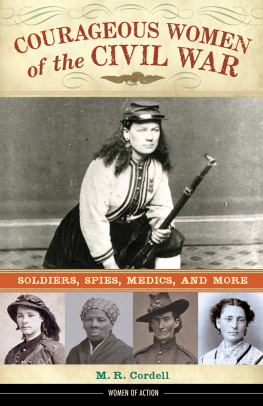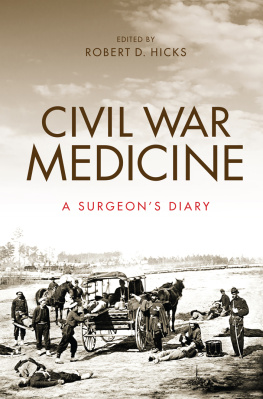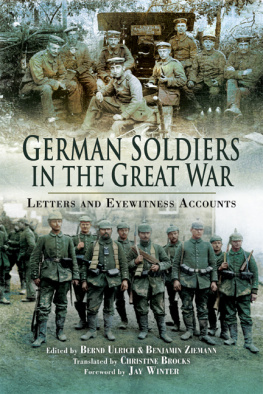Natures Civil War
CIVIL WAR AMERICA
Gary W. Gallagher, Peter S. Carmichael, Caroline E. Janney, and Aaron Sheehan-Dean, editors
This book was published with the assistance of the Fred W. Morrison Fund for Southern Studies of the University of North Carolina Press.
2013 The University of North Carolina Press
All rights reserved
Set in Miller by codeMantra
Manufactured in the United States of America
The paper in this book meets the guidelines for permanence and durability of the Committee on Production Guidelines for Book Longevity of the Council on Library Resources. The University of North Carolina Press has been a member of the Green Press Initiative since 2003.
Library of Congress Cataloging-in-Publication Data
Meier, Kathryn Shively.
Natures Civil War : common soldiers and the environment in 1862 Virginia / Kathryn Shively Meier.
pages cm. (Civil War America)
Includes bibliographical references and index.
ISBN 978-1-4696-1076-4 (cloth : alk. paper)
ISBN 978-1-4696-2649-9 (pbk. : alk. paper)
1. United StatesHistoryCivil War, 18611865Health aspectsVirginia. 2. United StatesHistoryCivil War, 18611865Environmental aspectsVirginia. 3. Self-care, HealthVirginiaHistory19th century. 4. Self-care, HealthUnited StatesHistory19th century. 5. Military lifeVirginiaHistory19th century. 6. Military lifeUnited StatesHistory19th century. I. Title. II. Title: Common soldiers and the environment in 1862 Virginia.
E 621. M 45 2013
973.775dc23
2013015620
Portions of this book were previously published in somewhat different form: No Place for the Sick: Natures War on Civil War Soldier Mental and Physical Health in the 1862 Peninsula and Shenandoah Valley Campaigns, Journal of the Civil War Era 1, no. 2 (2011); and The Lost Boys, Civil War Monitor 2, no. 3 (2012). Used with permission.
17 16 15 14 13 5 4 3 2 1
To
Louise, Jack, and Mark
Maps, Illustrations, Figures, and Tables
MAPS
Troop movements, Shenandoah Valley Campaign, March 23June 9, 1862,
Troop movements, Peninsula Campaign, March 17August 15, 1862,
ILLUSTRATIONS
The War in VirginiaA Reconnaissance in a Laurel Brake,
Soldiers Bathing, North Anna River, Va.Ruins of Railroad Bridge in Background,
Building Huts for the Army of the Potomac,
The Army of General Fremont on Its March up the Shenandoah ValleyWounded and Ragged Soldiers,
FIGURES
1. Number of soldiers sampled, by side and location,
2. Soldiers self-reported physical health as percentage of total, by side and location,
3. Soldiers self-reported mental health as percentage of total, by side and location,
4. Sick cases reported per 1,000 Union soldiers, JanuaryJune 1862,
TABLES
1. Overall Distribution of Self-Reported Health,
2. Correlations of Mental and Physical Health,
Acknowledgments
At one point in time, the manuscript of this book was absurdly replete with examples and unnecessarily didactic. Good-natured and highly respectable people more than did their parts in attempting to steer me back toward good history. All remaining folly is mine.
Chief among these people is Gary W. Gallagher. His advice kept me in graduate school in dark days, and his unflagging support and trust has bolstered my work and career incalculably since then. The passion and intellect he has dedicated to Civil War history make it impossible to imagine the field without him. I am profoundly grateful for his assistance on this project and astounded at my good fortune in being able to call him my mentor. Simply put, I would not be a historian if it werent for Gary.
Other scholars at the University of Virginia groomed this project when it was a mere twinkle in my eye. Edward Ayers, one of the busier men alive, set aside hours to counsel me through considerable growing pains and to sharpen the ideas contained herein. He is an intellectual force of nature and a man of boundless generosity. Edmund Russell, a leader among environmental historians, introduced me to a subfield I now cherish, and he took special care to help train me as a professional. His humility and meticulous work continue to inspire me. In an early draft, Margaret Mohrmann gently corrected my medical errors with good humor (though by no means should remaining gaffes be associated with her).
Archives and the people who run them helped to form the backbone of this project, the research. I am thankful to the special collections staff at the University of Virginia and the Library of Virginia, both treasures of Civil War collections. A large portion of my research was completed at the Military History Institute of the U.S. Army War College, where Martin Andresen gave generously of his time, despite being retired, and Richard Sommers kindly thought to check up on me. At the Museum of the Confederacy, John Coski provides a munificent welcome to all scholars and extended his resources to me. Other institutions critically provided funding for my project. The Suzanne and Caleb Loring Civil War Fellowship, which I held jointly at the Massachusetts Historical Society and Boston Athenaeum, provided invaluable research as well as comfortable spaces to ponder and write. I am sincerely indebted to Conrad Wright and also Peter Drummey, Sara Georgini, and Jeremy Dibbell at the MHS and Mary Warnement and Stephen Nonack at the Athenaeum, who provided feedback, support, and opportunities for public lectures during my stay in Boston. A well-timed Gilder Lehrman fellowship allowed me to sift through the U.S. Sanitary Commission papers at the New York Public Library, thanks to the help of Thomas Lannon, completing my research.
Mark Simpson-Vos sought out this project when I was a very green historian and then cultivated it for many years. In the process, he has proven to be an exceptional editor. At critical moments, he offered sage advice and encouragement, which helped turn the corner in a sometimes grueling journey. David Perry has also given freely of his time, while the readers reports helped to condense and refine the monograph, significantly enhancing its impacts. Series editor Peter Carmichael partook in the agony and, dare I say, the ecstasy of finally getting this manuscript off his desk. In between, he proved himself a perceptive and scrupulous editor, seeing value and complexity in my ideas of which I occasionally lost sight. Further, I am humbled and honored that this project was awarded the inaugural Edward M. Coffman First-Manuscript Prize by the Society for Military History in 2011. I delight in counting myself as one of the many young military scholars that Dr. Coffman has encouraged in his venerable career.
I consider many other readers of this project as esteemed colleagues and trusted friends. At the University of Scranton, David Dzurec has cheerfully shared with me the growing pains of developing a first manuscript. Professional opportunities brought me into contact with the infectiously ebullient Megan Kate Nelson, whose readings critically sharpened my prose and analysis, as well as the talented Aaron Sachs and his posse of discerning graduate students, who took me to task on chapter 5, and finally the munificent William Blair, whose character and scholarship inspires me. Bill is a tireless advocate of young scholars. Rachel Shelden has always championed my work, even when my own enthusiasm lagged. My career (let alone this book) would not have come to fruition without the editorial facility, wise counsel, and devoted friendship of Laura Kolar and Philip Mills Herrington. Peter Luebke is the most meticulous steward of Civil War scholarship imaginable. He has read this manuscript more times than anyone, and I am deeply obliged to and sometimes daunted by his formidable brain.






